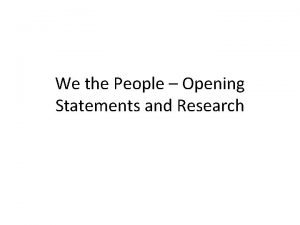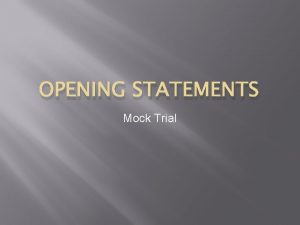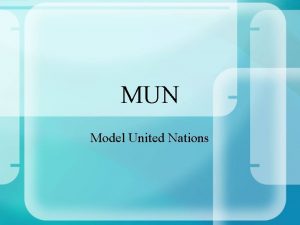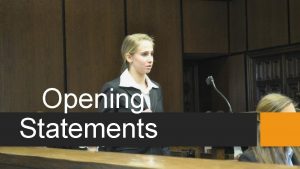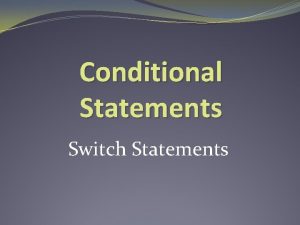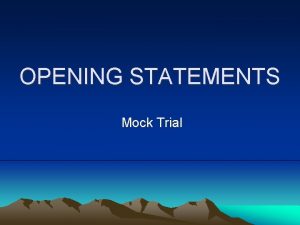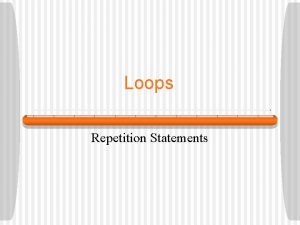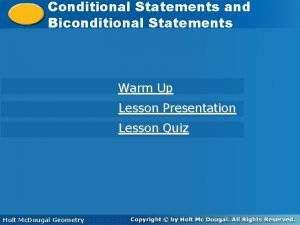Opening Statements Why is the opening statement important










- Slides: 10

Opening Statements

Why is the opening statement important? �First time judge & jury see the attorney �Good first impressions are important �Provide judge & jury with a “roadmap”

(1) Case Theory & Theme Your side’s version of “what really happened” ØLogical ØFit the legal requirements of the claims or defenses ØBe simple to understand ØBe consistent with the jurors’ common sense and their perception of how real life works

Theme �Memorable word or phrase that summarizes your theory ØEmotionally compelling ØIncorporate jurors sense of fairness and universal truths ØSimple ØFocus on people, not issues �Should translate “legalese” into simple, compelling, human propositions that are consistent with the attitudes jurors already hold about people, events, and life in general.

Theme: Examples Libel/Slander case: � Defense: Lukas Reiter was caught red-handed, and now he wants someone else to pay for his affair. � Plaintiff: Richard Mc. Kyton made a jealous jump to conclusions. Murder/Self Defense case: � Defense 1: With her back up against the wall and her roommate threatening to kill her, Ms. Hughes had run out of options. � Prosecution 1: Pat Hughes took the law into her own hands. � Defense 2: Facing death, Sarah Baker did what all living things are instinctively programmed to do…she defended herself. Counterfeit case – missing “other suspect”: � Defense: Reggie Jefferson had the perfect cover: A trusting roommate with the same initials. Negligence: � Defense: It is every driver’s worst nightmare. A small child darts into the road.

Opening Statements: What to Do? Tell a story. Ø Focus on the people, not the problem. Ø Who are the important players? Personalize your party. Ø Make the story vivid. Ø Re-create the incident. Make it emotional and dramatic KEEP IT SIMPLE. Be logical and concise. Ø Walk the jurors through the events in chronological order. Anticipate the other side’s weaknesses

What NOT to do? q Don’t overstate the evidence q Don’t include your personal opinions q Don’t argue - at least not in an obvious way

“By the Book” Outline Introduction Parties – introduce essential people Scene – paint a picture for the jury Issue – what is the main issue? What happened – get the jury to believe your side of the story 6. Basis of guilt/non-guilt – why your side should win 7. Anticipating and refuting the other side 8. Conclusion - Simply and directly tell jury that facts of the case will support his/her side, and ask for a verdict. 1. 2. 3. 4. 5.

In Normal People Terms… 1. Attention Getter – quick summary of theme/theory that draws jurors in 2. Introduction – who are you and who do you represent? 3. The Story Paint the scenes and introduce the players as they come up 4. Short close – return to/restate your theme 5. Charge the jury – tell them what you’re going to ask them to find

Video Clip �A Few Good Men with Tom Cruise � 1: 06: 10 to 1: 08: 45
 Pictures
Pictures Example of existential universal statement
Example of existential universal statement Dont ask why why why
Dont ask why why why Newspaper article format
Newspaper article format Inverted pyramid in news writing
Inverted pyramid in news writing Least important to most important
Least important to most important Who does oedipus claim to still fear in corinth?
Who does oedipus claim to still fear in corinth? How to start an opening statement
How to start an opening statement How to start an opening statement
How to start an opening statement Opening statement example
Opening statement example Main submitter speech example
Main submitter speech example







